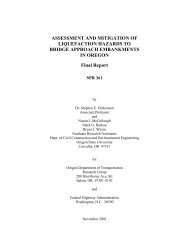Oregon Balance of State HIV/AIDS Housing & Services Systems ...
Oregon Balance of State HIV/AIDS Housing & Services Systems ...
Oregon Balance of State HIV/AIDS Housing & Services Systems ...
Create successful ePaper yourself
Turn your PDF publications into a flip-book with our unique Google optimized e-Paper software.
A-60 Appendices—<strong>Oregon</strong> <strong>HIV</strong>/<strong>AIDS</strong> <strong>Housing</strong> and <strong>Services</strong> <strong>Systems</strong> Integration Plan<br />
HOMELESS PERSON According to the U.S. Department <strong>of</strong> <strong>Housing</strong> and Urban Development, a homeless<br />
person is an individual or family who 1) lacks a fixed, regular, and adequate night-time residence, or 2) has a<br />
primary night-time residence that is a) a publicly supervised or privately operated shelter designed to provide<br />
temporary living accommodations (including welfare hotels, congregate shelters, and transitional housing for<br />
the mentally ill); b) an institution that provides a temporary residence for individuals intended to be<br />
institutionalized; c) a public or private place not designed for, or ordinarily used as, a regular sleeping<br />
accommodation for human beings. Individuals paying more than 50 percent <strong>of</strong> their income for housing are<br />
also considered at such high risk for homelessness that they are included in the definition <strong>of</strong> homeless for<br />
some federal programs. The term “homeless individual” does not include any individuals imprisoned or<br />
otherwise detained under an act <strong>of</strong> federal or state law.<br />
HOPE VI HOPE VI, or the Urban Revitalization Program, a program administered by the U.S. Department <strong>of</strong><br />
<strong>Housing</strong> and Urban Development, funds rehabilitation and/or replacement <strong>of</strong> distressed public housing units<br />
and support services.<br />
HOPWA <strong>Housing</strong> Opportunities for Persons with <strong>AIDS</strong>. A U.S. Department <strong>of</strong> <strong>Housing</strong> and Urban<br />
Development program which pays for housing and support services for people living with <strong>HIV</strong>/<strong>AIDS</strong> and<br />
their families. Part <strong>of</strong> the Consolidated Plan process, HOPWA was created by an Act <strong>of</strong> Congress in 1990.<br />
HOSPICE A support and care facility for people in the last phases <strong>of</strong> a terminal illness so that they may live<br />
as fully and comfortably as possible. Hospice focuses on alleviating pain and discomfort, improving the<br />
quality <strong>of</strong> life, and preparing individuals mentally and spiritually for their eventual death.<br />
HOUSING CHOICE VOUCHER PROGRAM (Formerly Section 8) A federal program operated by local housing<br />
authorities providing rental assistance to low-income persons and administered by the U.S. Department <strong>of</strong><br />
<strong>Housing</strong> and Urban Development. Under the <strong>Housing</strong> Choice Voucher (HCV) program, the local housing<br />
authority determines a standard amount <strong>of</strong> rental assistance an individual or family will receive. The tenant<br />
would pay the difference between the amount <strong>of</strong> assistance and the actual rent, which may require the tenant<br />
to spend more than 30 percent <strong>of</strong> their income on rent. The HCV program is a tenant-based program,<br />
meaning the subsidy is specific to the tenant as opposed to the unit. The following are HCV programs:<br />
• <strong>Housing</strong> Opportunities for Persons with Disabilities (Mainstream Program)<br />
The Mainstream Program, created in 1997 and administered by the U.S. Department <strong>of</strong> <strong>Housing</strong> and<br />
Urban Development, utilizes up to 25 percent <strong>of</strong> the funds originally earmarked for Section 811 to a<br />
separate tenant-based rental assistance program for persons with disabilities. Also see Section 811.<br />
• Moderate Rehabilitation for Single-Room Occupancy Dwellings<br />
This program provides Section 8 rental assistance for moderate rehabilitation <strong>of</strong> buildings with SRO<br />
units (single-room occupancy dwellings). The program, administered by the U.S. Department <strong>of</strong><br />
<strong>Housing</strong> and Urban Development, is designed for the use <strong>of</strong> an individual person. Units <strong>of</strong>ten do not<br />
contain food preparation or sanitary facilities. A public housing authority makes Section 8 rental<br />
assistance payments to the landlords for the homeless people who rent the rehabilitated units.<br />
HOUSING COST BURDEN The extent to which gross housing costs, including utility costs, exceed 30 percent<br />
<strong>of</strong> gross income, based on data published by the U.S. Census Bureau.<br />
SEVERE HOUSING COST BURDEN The level <strong>of</strong> burden at which gross housing costs, including utility costs,<br />
exceed 50 percent <strong>of</strong> gross income, based on data published by the U.S. Census Bureau.<br />
HOUSING UNIT An occupied or vacant house, apartment, or a single room (SRO housing) that is intended as<br />
separate living quarters.

















